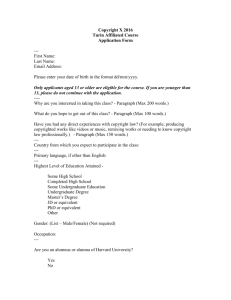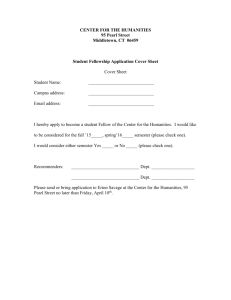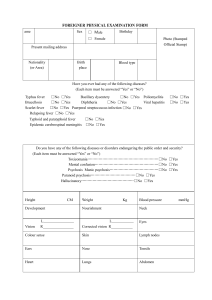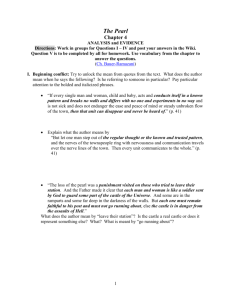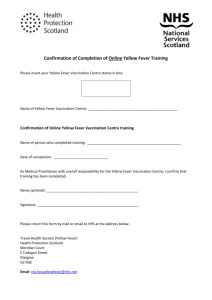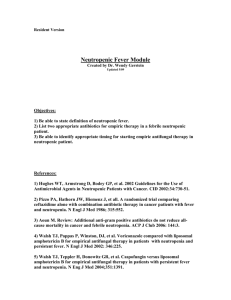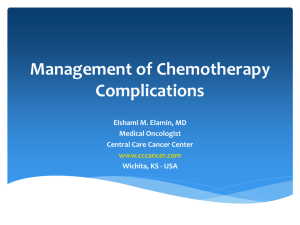Heme Onc Part 1 Show Notes (Word Format)
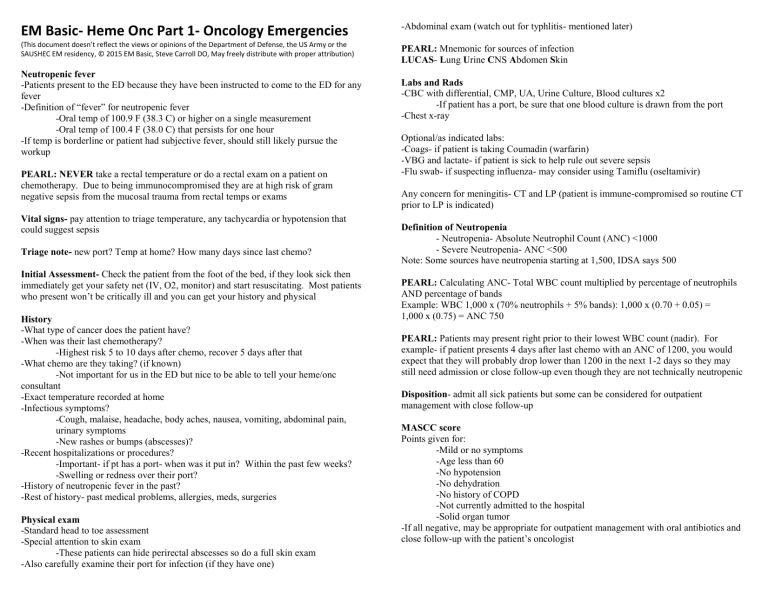
EM Basic- Heme Onc Part 1- Oncology Emergencies
(This document doesn’t reflect the views or opinions of the Department of Defense, the US Army or the
SAUSHEC EM residency, © 2015 EM Basic, Steve Carroll DO, May freely distribute with proper attribution)
Neutropenic fever
-Patients present to the ED because they have been instructed to come to the ED for any fever
-Definition of “fever” for neutropenic fever
-Oral temp of 100.9 F (38.3 C) or higher on a single measurement
-Oral temp of 100.4 F (38.0 C) that persists for one hour
-If temp is borderline or patient had subjective fever, should still likely pursue the workup
PEARL: NEVER take a rectal temperature or do a rectal exam on a patient on chemotherapy. Due to being immunocompromised they are at high risk of gram negative sepsis from the mucosal trauma from rectal temps or exams
Vital signs- pay attention to triage temperature, any tachycardia or hypotension that could suggest sepsis
Triage note- new port? Temp at home? How many days since last chemo?
Initial Assessment- Check the patient from the foot of the bed, if they look sick then immediately get your safety net (IV, O2, monitor) and start resuscitating. Most patients who present won’t be critically ill and you can get your history and physical
History
-What type of cancer does the patient have?
-When was their last chemotherapy?
-Highest risk 5 to 10 days after chemo, recover 5 days after that
-What chemo are they taking? (if known)
-Not important for us in the ED but nice to be able to tell your heme/onc consultant
-Exact temperature recorded at home
-Infectious symptoms?
-Cough, malaise, headache, body aches, nausea, vomiting, abdominal pain, urinary symptoms
-New rashes or bumps (abscesses)?
-Recent hospitalizations or procedures?
-Important- if pt has a port- when was it put in? Within the past few weeks?
-Swelling or redness over their port?
-History of neutropenic fever in the past?
-Rest of history- past medical problems, allergies, meds, surgeries
Physical exam
-Standard head to toe assessment
-Special attention to skin exam
-These patients can hide perirectal abscesses so do a full skin exam
-Also carefully examine their port for infection (if they have one)
-Abdominal exam (watch out for typhlitis- mentioned later)
PEARL: Mnemonic for sources of infection
LUCAS - L ung U rine C NS A bdomen S kin
Labs and Rads
-CBC with differential, CMP, UA, Urine Culture, Blood cultures x2
-If patient has a port, be sure that one blood culture is drawn from the port
-Chest x-ray
Optional/as indicated labs:
-Coags- if patient is taking Coumadin (warfarin)
-VBG and lactate- if patient is sick to help rule out severe sepsis
-Flu swab- if suspecting influenza- may consider using Tamiflu (oseltamivir)
Any concern for meningitis- CT and LP (patient is immune-compromised so routine CT prior to LP is indicated)
Definition of Neutropenia
- Neutropenia- Absolute Neutrophil Count (ANC) <1000
- Severe Neutropenia- ANC <500
Note: Some sources have neutropenia starting at 1,500, IDSA says 500
PEARL: Calculating ANC- Total WBC count multiplied by percentage of neutrophils
AND percentage of bands
Example: WBC 1,000 x (70% neutrophils + 5% bands): 1,000 x (0.70 + 0.05) =
1,000 x (0.75) = ANC 750
PEARL: Patients may present right prior to their lowest WBC count (nadir). For example- if patient presents 4 days after last chemo with an ANC of 1200, you would expect that they will probably drop lower than 1200 in the next 1-2 days so they may still need admission or close follow-up even though they are not technically neutropenic
Disposition - admit all sick patients but some can be considered for outpatient management with close follow-up
MASCC score
Points given for:
-Mild or no symptoms
-Age less than 60
-No hypotension
-No dehydration
-No history of COPD
-Not currently admitted to the hospital
-Solid organ tumor
-If all negative, may be appropriate for outpatient management with oral antibiotics and close follow-up with the patient’s oncologist
Outpatient antibiotic options
Cipro (ciprofloxacin) and Augmentin (amoxicillin/clauvanate)- most recommended by the IDSA
-Other options (not as well studied)
-Ciprofloxacin monotherapy
-Ciprofloxacin plus clindamycin
-Levaquin (levofloxacin) monotherapy
Inpatient IV antibiotic options
-Broad spectrum coverage
-Cefepime 2 grams IV or
-Meropenem 2 grams IV or
-Zosyn (piperacillin/tazobactam) 3.375 grams IV
Gram positive coverage- not recommended by IDSA for routine use
-Consider in patients who are hemodynamically ill, have a port infection, pneumonia, a skin or soft tissue infection
-Dosing- 15 to 20 mg/kg IV- alternative 25 to 30 mg/kg first dose for critically ill patients to achieve rapid therapeutic levels
PEARL: Make sure to dose your vancomycin by weight. Unless your patient weight 50 kilograms then the “standard 1 gram of vanc” will be an underdose. Max single dose is
2 grams
Tumor Lysis Syndrome
-Usually seen as a complication of hematologic malignancies such as leukemia
-Caused by a massive release of intracellular ions and proteins causing electrolyte abnormalities and renal failure
-Most worrisome- hyperkalemia and hyperphosphatemia
First step- aggressive hydration with IV fluids
Second step (in tandem with first step)- hyperkalemia/hyperphos treatment
PEARL: Be cautious in giving calcium in these patients because it may precipitate calcium phosphate in the kidneys. Only give calcium if the patient has arrhythmia on their EKG, a widened QRS, or seizures
Other hyperkalemia treatments- beta-agonists, bicarb, insulin/glucose (also treats hyperphosphatmia), dialysis for severe cases
Malignant Spinal Cord Compression
-Back pain in a patient with known or highly suspected cancer is a very worrisome chief complaint
-Pain is described as unremitting, worse at night or wakes from sleep, worse when supine (benign back pain usually better with rest and doesn’t wake from sleep)
-70% of malignant compressions occur in the thoracic spine
-If lumbar spine involved- may have symptoms of cauda equina
-Leg weakness
-Saddle (groin) anesthesia
-Bowel/bladder retention (early), bowel/bladder incontinence (late)
-Test of choice- MRI
-If MRI absolutely contraindicated- then CT with or without myelography
(catheter in spinal canal to deliver contrast)
PEARL: Even if patient only has lumbar symptoms, scan the thoracic spine as well because the mass can be up to 4 levels higher than the deficits or complaints
-Medications: Decadron 10mg IV
-Consults: Emergent consultation to radiation oncology for emergent radiation treatment to shrink tumor to limit loss of function, consider consult to spine surgery for tumor debulking
Superior Vena Cava (SVC) Sydrome
-Mass in the chest causes compression of the SVC
-Patients usually complain of facial or arm swelling, redness (plethora), may have voice changes or cough
-May have distended neck veins on exam
-Chest x-ray and CT chest with contrast to define tumor
-Treatment is usually not emergent unless signs or symptoms of increased intracranial pressure, usually treated with chemo or radiation
Pulmonary Embolism and Malignant Pericardial Effusion
-Patients with cancer are at high risk for PE- any chest pain or shortness of breath is PE until proven otherwise
-Pericardial effusions- usually from breast or lung cancer or chemo side effect
-Can be very large as they can accumulate very slowly, giving the heart a chance to adapt
-Symptoms of heart failure- chest pain/SOB, dyspnea on exertion
-Exam- muffled heart sounds (rare), distended neck veins
-EKG- electrical alternans (varying R wave height from heart swinging in the effusion), low R wave voltage
-Chest x-ray- may show cardiomegaly
-Bedside ultrasound- for diagnosis and to determine if tamponade (RV collapse)
-Unstable patients- may need pericardiocentesis in the ED as a life saving procedure
-Stable patients- effusion can be drained in the OR or cath lab

